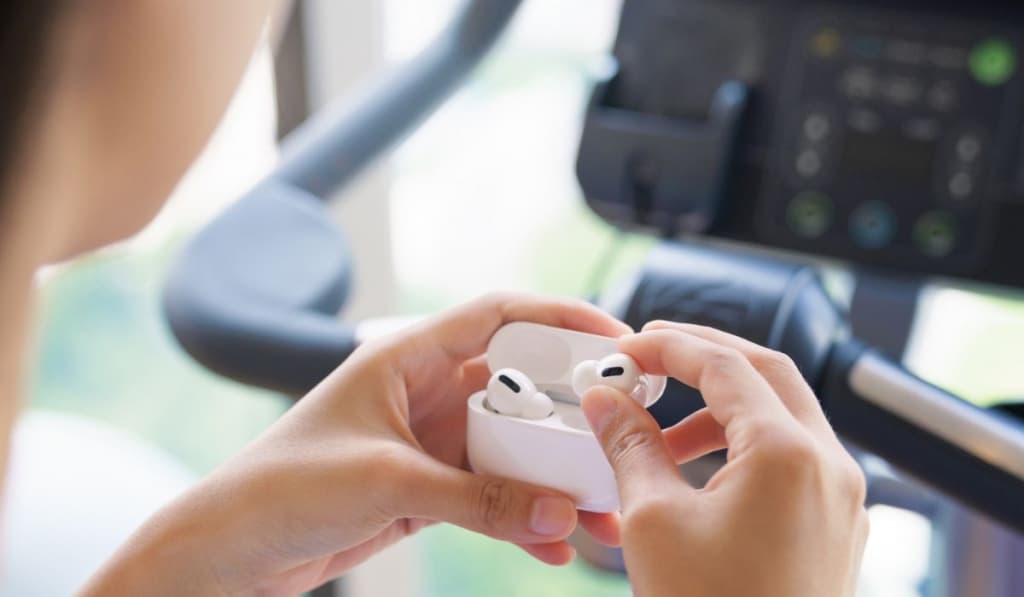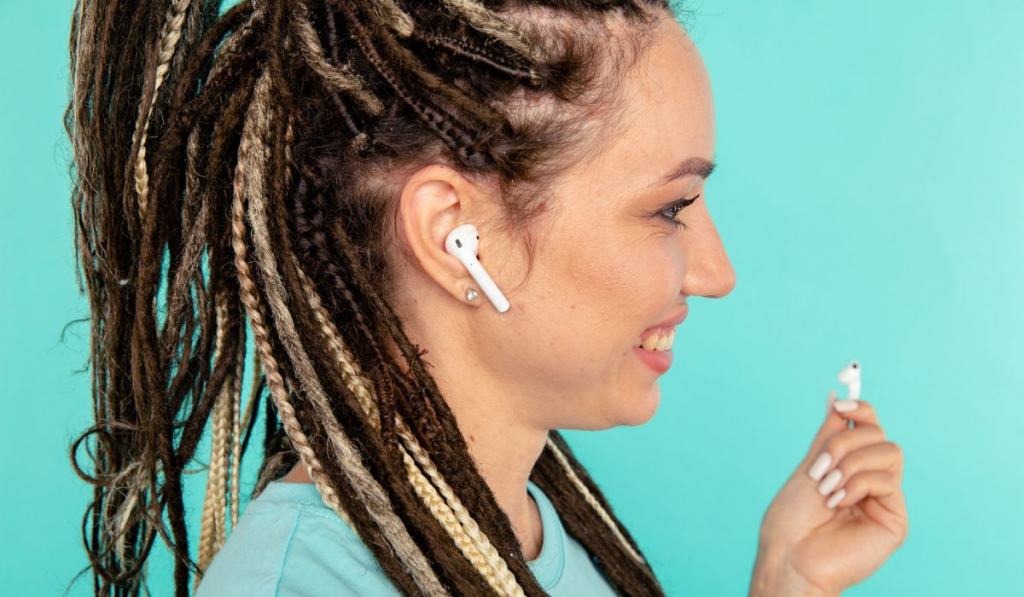Why Your AirPods Pro Can’t Double As Ear Protection
Listening to sounds above 85 decibels regularly can damage your hearing in the long run. If you live or work in an area where there’s a lot of noise, you’ll need some sort of ear protection to cancel out external sound. But what about the noise-cancelling AirPods Pro? Can they double up as ear protection?
The AirPods Pro can add some protection to your ears with active noise cancellation and sound reduction, But they aren’t designed to be used as a safety device and won’t block out very loud sounds. They may also encourage you to listen to louder music, which is worse for your hearing.
Let’s look at why you shouldn’t rely on the AirPods Pro for ear protection and how you can listen to music safely. We’ll also explore how to protect your ears in a noisy environment if you’re using AirPods Pro and which earphone is optimal for ear protection.
Do AirPods Pro Work as Ear Protection?

AirPods do work as a form of ear protection since they can block sounds that may be damaging to your hearing. The AirPods Pro (on Amazon) have a built-in noise-canceling feature that helps with noise reduction, and since you’ll be using them to listen to music, reducing external noise levels results in better quality audio.
However, the usefulness of AirPods as ear protection depends on what type of environment you’re planning on using the AirPods in and for how long. If you’re in a high noise environment, such as a construction site etc., there is no proof that the AirPods Pro would cancel out enough noise from your inner ear to prevent hearing loss over time.
You can still get hearing damage if you crank up the volume on the AirPods and listen through them all day. In a high noise work environment, companies don’t permit workers to use AirPods Pro as a means of ear protection as they do not meet the standard for those environments. Blocking out sounds when you’re working in a factory or construction site could also be risky.
However, AirPods are useful for blocking out external sounds and noises in low noise environments such as gyms, offices, and local parks. While AirPods Pro and other earphones with noise cancellation are safer than regular headphones, the AirPods Max (on Amazon) is ideal.
It comes with spatial audio, active noise cancellation, and a transparency mode that’s easy to switch to in case you need to listen to external noises.
It’s also shaped like a classic pair of headphones for better audio distribution. A headphone design is also safer as you don’t have to worry about the earphone going too deep inside your ears.
If you work in a noisy environment and you’re allowed to use headphones on the job, the AirPods Max are a great option. However, just like other AirPods, they can’t double up as ear protection in all cases.
What Is Considered Ear Protection?
The main purpose of ear protection is to prevent hearing loss by blocking out any sound or noise higher than 85 decimals (which is the occupational exposure limit). Ear protection should reduce your noise exposure levels and prevent hearing loss over time.
There are two subgroups of ear protection devices: sound reduction and noise-canceling devices. There is some debate about whether noise cancelling devices should be considered as ear protection or not, but most experts believe that noise-canceling devices such as the AirPods Pro don’t do enough to be considered ear protection, especially in high noise environments.
So what is sound reduction and noise cancellation, and how do they work?
Noise Cancelation vs. Sound Reduction
Noise cancellation is basically a system that counters noise interference by measuring it and then producing its own wavelengths. It doesn’t block out any noise but rather counters it with sounds of its own.
Sound reduction, on the other hand, is something like a noise-canceling headphone that blocks out the most harmful noises from your ear by creating a physical barrier between the two.
Noise-canceling devices such as the AirPods Pro are designed to block out background noises in low to medium noise environments. Even then, it’s recommended to keep the volume below the highest option.
If, for instance, a person is speaking with you and you can’t hear what they’re saying, even though they’re just a few feet away, then the volume on your AirPods Pro is too high, and this could lead to hearing damage.
So, noise cancellation devices may be used as ear protection in low-risk environments and shouldn’t be used at high volumes for long periods at a time. Another downside is that you will have no protection once the battery life runs out.
Sound reduction devices, on the other hand, are designed mainly for high-risk, high-noise environments such as construction sites and helipads. These sound reduction devices, such as over-ear protectors and sound reduction headphones, have a very high success rate at preventing high sound pressure levels from entering your ears.
In case you’re wondering whether you can just use any headphones as ear protection, here’s a look at which kinds would and wouldn’t work.
The 3 Types of Headphones
The first type of headphones are those that don’t have a seal of any kind to block out external sounds. Examples of these are normal earphones and AirPods; they don’t really block out any sounds, even in low noise environments such as your home.
The next type of headphones are ones that offer ‘passive’ noise reduction because they form a seal around your ear and prevent a portion of the noise from reaching it. These are the headphones that usually have a silicone seal around them, and they fit into your ear, blocking out noise and providing you with sound entertainment.
Passive noise reduction headphones work well in low noise areas.
The last type of headphones are the ones that offer active noise canceling because they actively cancel out external sound waves by creating an anti-noise effect. They pick up the wavelength of the external sound through a built-in external microphone and then instantly play a sound to counter it.
AirPods Pro are a great example of these types of headphones, and the only issue with them is that if the external sound is very loud, the music you’re listening to will get higher as well.
Can AirPods Pro Damage Your Ears?
The AirPods Pro (check out our review) are designed to give you the best possible experience with your headphones. They also have a noise-canceling feature that helps in blocking out moderate-level sounds. However, if this is used recklessly, it could end up damaging your ears.
This AirPods Pro can reduce external noises by up to 23 decibels. However, in higher noise environments, the volume level of the AirPods increases as well, as they’re not designed to act as an ear protection device against loud noises.
This could result in ear damage because if the ear is exposed to high sound levels for a long period of time, the hearing ability of the ear is reduced significantly.
Even if the noise volume doesn’t increase automatically, you’ll subconsciously increase the volume to adjust for external noise. This combination of noise reduction and high volume will damage your ears much faster than regular earphones.
A safe time span to use your AirPods Pro at 80 percent volume is for one and a half hours at a time, and if you desire to use it for longer than this, you should lower the volume.
It’s also recommended not to use your AirPod Pro as an ear protection device at work but to rather use the devices which are approved for handling the nose in the environment in which you work.
Tips for Listening to Music at a Safe Volume

Hearing loss is a real issue, and up to 20 percent of Americans suffer from hearing loss. Listening to music at high volumes can reduce your hearing function by 50% faster than normal.
Many headphones produce a sound output of higher than 85 decibels, an amount that could result in long-term hearing loss. However, there are ways to make sure that you’re listening to music at a safe volume.
Firstly, if someone standing a few feet away from you can hear the music from your headphones, then it’s definitely too loud and needs to be turned down. Also, if you have a hard time hearing what someone has said even though they’re close to you, then it’s also a good indication that the volume is too loud.
It isn’t only about the volume but also the amount of time that you spend listening to music through your headphones. Put a time limit on how much you use your headphones, and if you really have to exceed that time limit, then slowly reduce the volume over time. You should also never listen to music at full volume.
If you’re used to listening to music at high volume and can’t adjust to lower volumes, try avoiding the headphones for a day or two. Once your ears become accustomed to normal sound levels, you can start listening to music at a safe volume.
How to Listen to Music With Ear Protection
Working for long hours in a high noise environment can be very boring and stressful. So, if you wish to have ear protection while still being able to listen to music, don’t worry. There are several options that allow you to do just that.
There are many types of hearing protectors that allow you to listen to music, such as FM radio or even connect to Bluetooth, and these won’t necessarily blow your budget either. These headphones are different from normal headphones in that they are certified sound protectors and don’t exceed 85 decibels in the headphone.
This means that you won’t have to worry about hearing loss from either the high noise environment or from the headphone’s sound itself.
Headphones like the ISOTunes Link Muffs (on Amazon) are perfect for both everyday use and the professional work environment. These headphones offer Bluetooth connectivity, excellent sound quality, and, most importantly, great ear protection.